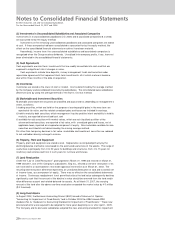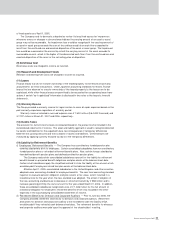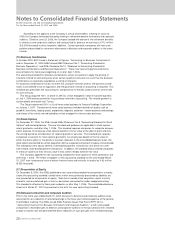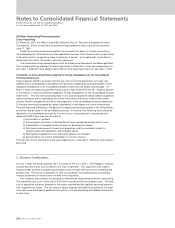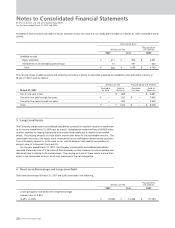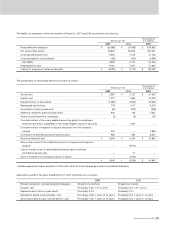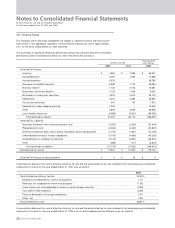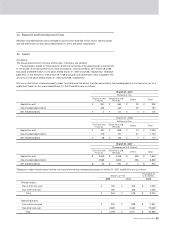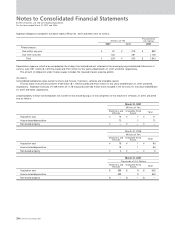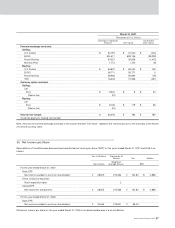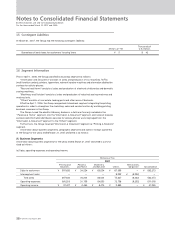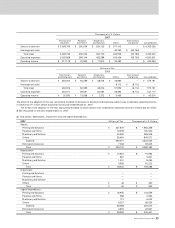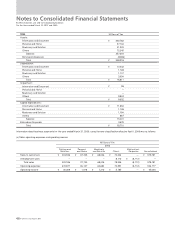Brother International 2007 Annual Report Download - page 32
Download and view the complete annual report
Please find page 32 of the 2007 Brother International annual report below. You can navigate through the pages in the report by either clicking on the pages listed below, or by using the keyword search tool below to find specific information within the annual report.
30 Brother Annual Report 2007
Notes to Consolidated Financial Statements
Brother Industries, Ltd. and Consolidated Subsidiaries
For the Years ended March 31, 2007 and 2006
8. Equity
On and after May 1, 2006, Japanese companies are subject to a new corporate law of Japan (the
“ Corporate Law ” ), w hich reformed and replaced the Commercial Code of Japan (the “ Code” )
with various revisions that are, for the most part, applicable to events or transactions w hich occur
on or after May 1, 2006 and for the fiscal years ended on or after May 1, 2006. The significant
changes in the Corporate Law that affect financial and accounting matters are summarized below :
(a) Dividends
Under the Corporate Law , companies can pay dividends at any time during the fiscal year in
addition to the year-end dividend upon resolution at the shareholders meeting. For companies
meet certain criteria such as; (1) having the Board of Directors, (2) having independent auditors,
(3) having the Board of Corporate Auditors, and (4) the term of service of the directors is
prescribed as one year rather than tw o years of normal term by its articles of incorporation.
The Board of Directors may declare dividends (except for dividends in kind) at any time during
the fiscal year if the company has prescribed so in its articles of incorporation. The Company
meets all the above criteria.
The Corporate Law permits companies to distribute dividends-in-kind (non-cash assets) to
shareholders subject to a certain limitation and additional requirements.
Semiannual interim dividends may also be paid once a year upon resolution by the Board
of Directors if the articles of incorporation of the company so stipulate. The Corporate Law
provides certain limitations on the amounts available for dividends or the purchase of treasury
stock. The limitation is defined as the amount available for distribution to the shareholders, but
the amount of net assets after dividends must be maintained at no less than ¥3 million.
(b) Increases / decreases and transfer of com m on stock, reserve and surplus
The Corporate Law requires that an amount equal to 10% of dividends must be appropriated
as a legal reserve (a component of retained earnings) or as additional paid-in capital (a component
of capital surplus) depending on the equity account charged upon the payment of such dividends
until the total of aggregate amount of legal reserve and additional paid-in capital equals 25% of
the common stock. Under the Corporate Law, the total amount of additional paid-in capital and
legal reserve may be reserved w ithout limitation. The Corporate Law also provides that common
stock, legal reserve, additional paid-in capital, other capital surplus and retained earnings can
be transferred among the accounts under certain conditions upon resolution of the shareholders.
(c) Treasury stock and treasury stock acquisition rights
The Corporate Law also provides for companies to purchase treasury stock and dispose of
such treasury stock by resolution of the Board of Directors. The amount of treasury stock
purchased cannot exceed the amount available for distribution to the shareholders w hich is
determined by specific formula. Under the Corporate Law , stock acquisition rights, which
were previously presented as a liability, are now presented as a separate component of equity.
The Corporate Law also provides that companies can purchase both treasury stock acquisition
rights and treasury stock. Such treasury stock acquisition rights are presented as a separate
component of equity or deducted directly from stock acquisition rights.
9. Stock Option
The stock option outstanding as of M arch 31, 2007 is as follow s:
2007 Stock Option 6 directors 46,000 shares Mar 19, 2007 ¥1
($ 0.008)
30 years starting on the
follow ing day of stock
option grant date
Stock Option Persons
Granted
Num ber of
Options Granted
Date of
Grant
Exercise
Price Exercise Period


